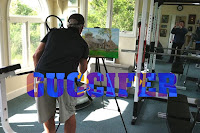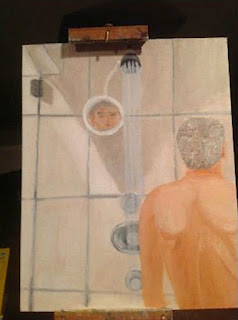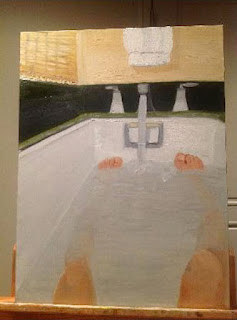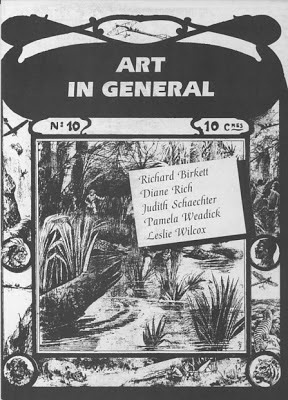 |
| George W. Bush, the Artist |
If you haven’t already heard about Bush’s art, here’s the situation. On October 14, New York Magazine reported that our 43rd president had “taken up painting, making portraits of dogs and arid Texas landscapes.” On February 1, we got to see one of these dog paintings first hand on Laura and George’s respective Facebook pages. It was a portrait of the Bushs’ late Scottish Terrier Barney, and it was surprisingly good. Although it’s a bit hard to figure out where the fur ends and a black dog sweater begins, Bush handles Barney’s fur, ears, and eye like a pro. Or at least like an art school freshman experimenting with impressionistic doggy portraiture.
 |
| Bush apparently signs his work "43" |
Anyway, on to the scandalous part. Early this month some dude (chick?) calling him(her?)self Guccifer hacked into a Bush family computer. It wasn’t all fun and games. He (she?) got security codes, addresses, phone numbers, and incredibly personal information. Including a horrible photo of Bush Senior in the hospital and plans for his funeral. It was bad. The FBI has launched a criminal investigation.
But what we’re interested in is not Bush 41’s health scare or clandestine information. It’s the art. There was a photo of Bush painting a picture of St. Ann’s Episcopal Church in Kennebunkport, Maine, but we’re going to ignore this painting too. It’s tiny, hard to see, and boring. Although it is interesting to note that Bush paints in the midst of exercise equipment.
 |
| He looks like he’s about to play tennis |
No, Guccifer found the true treasures in an email from Bush to his sister Dorothy. They appear to be self-portraits. Naked. In a bathroom.
The first shows our former president standing in the shower, his back to us. It’s not sophisticated. In fact, it’s awkward and naive. Bush isn’t under the water. He’s facing the wrong direction, standing so close to the wall he looks like a toddler in time-out. And the apparent reflection of his face in the mirror just below the shower head is totally impossible. Not to mention those back muscles.
But the painting does have something going for it. For one, I sort of like the angle and shadows created by the glass of the shower door (see the hinge in the top left?). Beyond that though, it has an interesting emotional impact. It’s unnervingly bizarre, and yet so mundane and thoughtful that we actually start to empathize with Bush. It’s like he’s a real human being, taking showers just like the rest of us.
The second painting has all the emotion of the first, but with the added bonus of showing some formal artistic potential (I chose this one!). The knees could use a little work, but I really like the toes and hint of leg beneath the water. But mostly I like the depth. The angles of the walls and the tub, although off, really lead you into the painting. And did you see the faucet? While it looks more like a sink faucet than one on a bathtub, the tuned handle, the contrast of light and shadow, and even the stream of water are actually pretty good. Plus, I always love art made from the perspective of the subject. It’s like you’re inside the painting.
Everyone’s been trying to psychoanalyze these paintings, making connections to Hurricane Katrina, waterboarding, and even gay marriage (they assumed the reflection in the shower painting was of some other dude standing behind Bush). But Bush is just one more painting politician in the company of Dwight D. Eisenhower, Winston Churchill, and Hitler. And in the end, I’m not sure I should be the one to judge him. I can’t remember what I was thinking, but even I once made a naked shower painting.
 |
| Can you tell which politician did which painting? |









